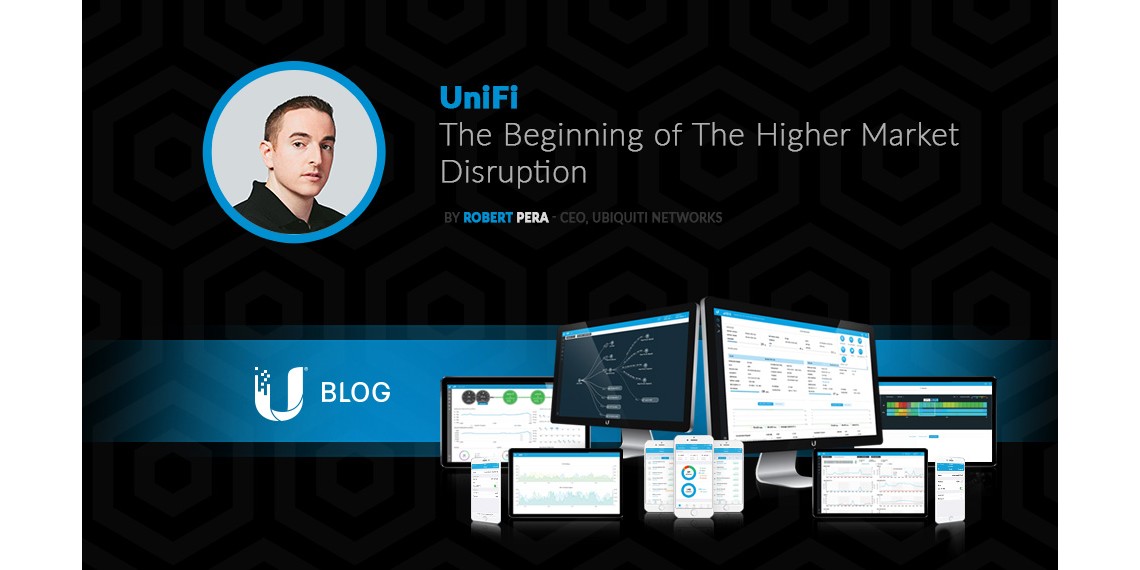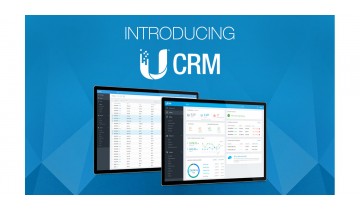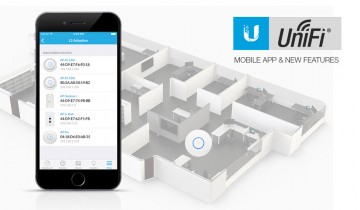
UniFi - The Beginning of The Higher Market Disruption
How An Outdoor Wireless Company Entered the Enterprise WiFi Market
by Robert Pera
Perhaps now hard to believe, Ubiquiti’s decision to enter a new market with the introduction of UniFi in 2010 was generally criticized. At that time, some questioned why a company driving explosive growth in the outdoor Wireless Internet Service Provider Industry would risk diverting their focus. Others questioned how Ubiquiti, having less than 25 employees and none of them marketing or sales people, could possibly enter a market dominated by traditional sales models. Nevertheless, I saw an Industry ripe for disruption and a perfect opportunity for us to leverage our core strengths.
Exactly why was it so compelling? In 2009, if you took apart a $1,000+ “Enterprise WiFi” AP and compared it to a <$50 consumer WiFi AP, you would see 90% component/material overlap. Enterprise vendors were essentially over-engineering consumer WiFi reference designs for often little more than incremental performance benefit and then dramatically over-charging for them. Ubiquiti’s past success was attributed to a completely opposite philosophy — making designs more cost-efficient (while enhancing performance) and passing savings on to the customer. And our increasing economy of scale at this point (1mm+ AirMax radios/ yr) reinforced what I saw as an excellent Enterprise WiFi opportunity. I believed a solution at just a fraction of the cost combined with a basic features set and some “Ubiquiti magic” would find its way to disrupting the market and breaking the established IT sales dynamics.
What exactly do I mean by “Ubiquiti magic?” Well, market timing and cost-disruption alone do not make a disruptive product. If they did, then many vendors focused on low-cost hardware plays wouldn’t be struggling with marketshare and achieving profitability. There is a reason why Ubiquiti, a cost leader, is also by many metrics the most profitable hardware company in the world. Making disruptive products also requires a kind of design magic — something that conveys to the customer qualities of premium craftsmanship, thoughtful usability, and ingenuity which in turn spark intrigue and evangelism. In fact, many people think it was our user community that lifted our brand and products to success, but it very likely was the other way around.
Here are a few examples of “Ubiquiti magic” inherent in the UniFi platform launch in 2010:
1. The “UniFi” marketing brand
“Uni” — which means to combine multiple pieces into one; paired with “WiFi” creates “UniFi” — the perfect name for a system that manages multiple WiFi AP’s within a single control plane. Even better, this word transcends languages nicely — this is important as non-native English speakers makeup a big part of our customer base.
.jpg)
2. The industrial design
Inspired by the Airport Extreme project I worked on at Apple, but optimized for wall and ceiling installation. Lower-profile dimensions for a seamless mounted presentation and antenna patterns optimized to direct energy angled out. A glowing circular LED ring was used to give the product a “personality” that changed colors according to device state. (a design element that was quite original at the time)
.jpg)
3. The 3-Pack
Also a unique idea at the time was the AP 3-pack which framed the marketing message that UniFi was a scalable system. (Today we have evolved to 5-packs to support the higher installation count of typical UniFi deployments)
.jpg)
The Performance Story

To those who have followed UniFi’s history, it is no secret that we struggled post-launch to improve performance and quality of the platform. Following the initial success of the product, we urgently needed to improve across multiple areas including feature expansion, wireless performance, better quality control, and more attention to user experience. Disappointingly, we just failed to execute. So what exactly happened? Sometimes a development team that is good in taking a project from concept to market is not the team best suited to scale and perfect. Eventually we made the tough decision to pivot towards a complete restructuring of the platform development team and strategy. (Similar to our pivots in the Airmax world at around the same time).
As a result of these changes, we started executing far more effectively across all key performance areas of the platform as well as introducing new products and technologies at a rapid pace. While it may have looked like growth was slowing just a couple years ago, UniFi is now re-accelerating, growing faster than ever before and recently becoming the highest volume shipping Enterprise WiFi platform in the world. Even more exciting, we are on the brink of a second-wave of disruption, attacking the higher ends of the market and not because of cost, but because many believe UniFi is now simply the best all-around performing platform in the Industry and here is why:
1. Performance
A true enterprise WiFi AP today should be fast, resilient, and reliable. It should be near-ethernet speed under light load, provide solid performance and low-latency under heavy loads and interference, as well as maintain stability at all times — even when faced with possibly any of thousands of older quirky 802.11 legacy devices fighting for air time. The UniFi platform was always effective in delivering elegant AP management, but it wasn’t until last year that we achieved true enterprise wireless performance — and we haven’t stopped there. In fact, by many accounts, UniFi has now quickly ascended to be the top performing WiFi Solution in the Industry.
.jpg)
To get to this level of performance has been an exercise in persistently testing and optimizing of the wireless driver performance with rapid iteration. In fact, we have built teams to develop tools just to allow us to conduct testing more efficiently. These tools combined with the transparent feedback of our community, who have collectively deployed 10mm+ AP’s, has enabled us to make excellent progress in a short amount of time.
.jpg)
2. User Experience
IT solutions are generally intimidating to operate and have configuration interfaces proprietary in nature. Traditional companies have used these as an advantage by creating training and certification classes which “lock in” system integrators after they have invested into the deep learning curve. We have taken a very different approach. While UniFi has tons of advanced functionality, we constantly strive to build a user experience that is visually intuitive and can very quickly be mastered by nearly anyone with a general networking background. Furthermore, the UniFi interface is designed to elegantly manage different technologies across different geographic locations all within a single framework.
.jpg)
.jpg)
3. Customer Service
It is widely known that Ubiquiti hosts a powerful community of system integrators who, together with our R&D, evangelize, improve, and support the UniFi platform. But UniFi also offers very responsive email support and real-time 24/7 online chat built into the controller, available free of charge.
.jpg)
4. WiFi Product Breadth
UniFi offers a comprehensive family of Access Points covering various applications including outdoor wifi, hospitality, education, and enterprises — each with unique form-factors designed specifically for their application use.
.jpg)
5. Feature Expansion
The UniFi team continues to expand the platform with new features including Integrated Radius server with insights for advanced installations, fully customizable hotspots with detailed analytics, as well as powerful deep-packet inspection reporting to characterize network use.
.jpg)
6. Technology Expansion
While UniFi is known as a WiFi system, it is rapidly expanding to adjacent technologies. The UniFi switching portfolio is quickly gaining market share and we are focused this year on bringing higher-end gateways, application servers, and other technologies to market — all managed within the UniFi controller.
.jpg)
A Second Wave of Disruption
Interestingly, while UniFi’s performance has dramatically improved over the past couple years, we have been even more aggressive in our pricing strategy. For example, where our top selling 802.11n UAP Pro was priced at $229 MSRP, we introduced our UAP AC PRO (with several times higher performance) at $149 MSRP. We followed this up with very low entry points for our UAP AC Mesh and UAP AC Inwall each at $99 MSRP as well as with our hi-density POE Switching family also starting at $99 MSRP.
The obvious question — why would we sacrifice margins and profitability when we don’t have to? While it is true the above products would still be successful even at significantly higher pricing, we made a conscience decision to reduce short-term profits in an effort to maximize UniFi brand awareness, build greater long-term competitive advantage, and force the Industry’s attention to our marketshare gains. In turn, our hope was that UniFi’s performance could stand on its own and ultimately be recognized as a legitimate solution for higher-end markets.
And just as we hoped, UniFi (even without a sales force behind it) is now starting to make its way up-market into a more demanding customer base — one who values performance just as much as price. And in preparation of this next phase of evolution, we have been working towards a new product portfolio along with an advanced hosting and support solution . Specifically our “HD and “XG” series of products brings high density client support and 10Gigabit performance across WiFi AP’s, switches, and gateways. These new products are complimented by our UniFi Elite service launching this year that will offer a complete hosting solution, advanced RMA replacement, lifetime warranty, and expert-level phone support.
.jpg)
Article originally published on the Ubiquiti Blog: https://goo.gl/ftY9Tc




